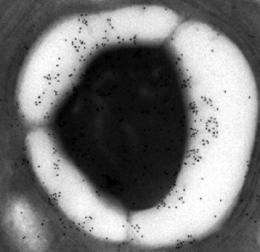Could the ingestion of 'modified' starch be a new malaria vaccine strategy?

There is no efficient vaccine against malaria, although nasal and oral vaccination seems to be the most promising and suitable solution in countries where the parasite Plasmodium, which causes the disease, is rife. Researchers from two laboratories in northern France have successfully vaccinated and protected mice by feeding them starch derived from green algae and genetically modified to carry vaccine proteins. These encouraging results, which make it possible to envisage a simple and safe vaccination for children in countries at risk, are available online, on the scientific journal PloS One's website.
According to the WHO, malaria affects approximately 300 to 500 million people worldwide and kills one million each year, mostly young children. Insecticide-resistant mosquitoes carrying the disease and multi-drug resistant parasites are on the increase. In this context, the development of a vaccine that alleviates symptoms and reduces mortality would be a valuable new tool in the fight against malaria. Researchers aim to test the efficacy of vaccine candidates among proteins that allow the parasite to penetrate host cells and infect them, in order to devise the best strategy for vaccine delivery.
Researchers from the Centre d'Infection et d'Immunité de Lille and the Unité de Glycobiologie Structurale et Fonctionnelle have developed a new vaccine strategy based on the ingestion of genetically modified starch. They used antigens that have shown their efficacy in “conventional” vaccinations as vaccine candidates. They fused these antigens to an enzyme (GBSS) in a starch granule from the green algae, Chlamydomonas reinhardtii. This enzyme has the particularity of functioning inside the starch granule and of being protected, along with the antigens grafted to it, against degradation by other enzymes. In this way, the researchers were able to produce several murine and human antigens of Plasmodium within starch grains. These grains were then ingested by mice inoculated with the parasite. The researchers demonstrated that the mice were vaccinated by the starch grains, which significantly protected them against infection.
Starch is the insoluble and semi-crystalline polysaccharide that is the most commonly found in photosynthetic organisms. A starch grain can easily be produced from a plant extract and purified, in large quantities. It has a very stable structure and can be stored for months with no particular precaution, even if it undergoes temperature variations. It is easily assimilated through digestion and has a major ecological and financial interest, with very low production costs.
The starch of edible plants could be transformed in the same way as that of the algae Chlamydomonas reinhardtii. Researchers are thus looking at the possibility of using starch from multi-cellular algae used in Africa as a food supplement, but also from maize and potatoes. Administered to children under 3 years of age, who are at high-risk of malaria-related mortality, such plants could be both a food source and a vaccine. This strategy would allow simple vaccination, avoid storage problems and syringes, and thus eliminate potential HIV contamination.
The vaccine strategy based on the ingestion of genetically modified starch is protected by a patent.
The researchers now plan to test the efficacy of various Plasmodium antigens and determine whether such strategy can be applied to humans by verifying it has no side effects.
More information: PloS One, 15 December 2010: www.plosone.org/article/info%3Adoi%2F10.1371%2Fjournal.pone.0015424 .


















